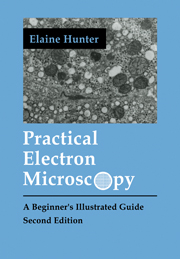Chapter 6 - The Electron Microscope Peter Maloney
Published online by Cambridge University Press: 05 June 2012
Summary
INTRODUCTION
The purpose of this chapter is to acquaint not only the novice electron microscopist, but also the seasoned user, with the principles of physics and mechanics as they apply to a typical transmission electron microscope (TEM). It is not the intention of the author to make electron-optic design engineers out of beginners but rather to give a basic understanding of the various systems that comprise the modern TEM. This chapter will also discuss certain criteria that must be met in order to optimize a TEM image and how the user can identify and subsequently correct common faults.
Figure 6.1 shows a typical modern TEM, which may be found in any research, quality control, or hospital pathology laboratory. To anyone who has never used a TEM the mere size and number of controls can be quite intimidating. However, if one thinks of an electron microscope as a large light microscope (LM), with which most people are familiar, then the TEM becomes less intimidating.
Figure 6.2 (left) is a ray diagram of a typical compound light microscope. It can be seen that four basic components are required in order to form a magnified image of an object at the eye. (1) A source of illumination is needed, which can be as simple as a light bulb. (2) A lens is needed to focus the light onto the specimen; this is called a condenser lens.
- Type
- Chapter
- Information
- Practical Electron MicroscopyA Beginner's Illustrated Guide, pp. 103 - 134Publisher: Cambridge University PressPrint publication year: 1993



